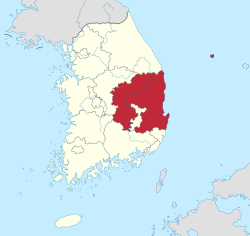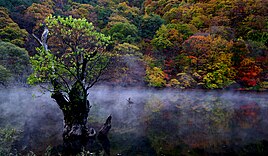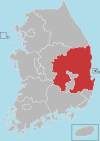North Gyeongsang Province
North Gyeongsang Province
경상북도 | |
|---|---|
| Korean transcription(s) | |
| •Hangul | 경상북도 |
| •Hanja | KhánhThượngBắcNói |
| • McCune‑Reischauer | Kyŏngsang-bukto |
| • Revised Romanization | Gyeongsangbuk-do |
 | |
| Country | |
| Region | Yeongnam |
| Largest city | Pohang |
| Capital | Andong |
| Subdivisions | 10 cities; 12 counties |
| Government | |
| •Governor | Lee Cheol-woo (People Power) |
| Area | |
| • Total | 19,030 km2(7,350 sq mi) |
| • Rank | 1st |
| Population (October, 2014)[1] | |
| • Total | 2,700,328 |
| • Rank | 3rd |
| • Density | 141.7/km2(367/sq mi) |
| Demonym | Gyeongbukite |
| Metropolitan Symbols | |
| • Flower | Crape-myrtle |
| • Tree | Zelcova |
| • Bird | Common heron |
| GDP | |
| • Total | KR₩115 trillion US$92 billion (2022) |
| ISO 3166 code | KR-47 |
| Dialect | Gyeongsang |
| Website | Official website (English) |
North Gyeongsang Province(Korean:경상북도,romanized:Gyeongsangbuk-do,Korean pronunciation:[kjʌŋ.saŋ.buk̚.t͈o]) is aprovincein easternSouth Korea,and with an area of 19,030 km2(7,350 sq mi), it is thelargest provincein theKorean peninsula.The province was formed in 1896 from the northern half of the formerGyeongsangprovince, and remained a province ofKorea(asKeishōhoku-dōduring Japanese rule) until the country'sdivisionin 1945, then became part ofSouth Korea.
Daeguwas the capital of North Gyeongsang Province between 1896 and 1981, but has not been a part of the province since 1981. In 2016, the provincial capital moved from Daegu toAndong.[3]
History
[edit]The 1,000-year-oldSilla Kingdomflourished and unified the previousthree kingdoms.The area was named Gyeongsang-do in 1314 during theGoryeo Dynasty.In 1896, during theJoseon Dynasty,the area was renamed Gyeongsangbuk-do as 13 roads were reorganized. The current administrative district was reorganized with the reorganization of Bu, Gun, and Myeon in 1914.[4]
Geography and climate
[edit]The province is part of theYeongnamregion,bordered to the south bySouth Gyeongsang Province,to the west byNorth JeollaandNorth Chungcheong Provinces,and to the north byGangwon Province.It is largely surrounded by mountains: theTaebaek Mountainsin the east and theSobaek Mountainsin the west.[citation needed]
Culture
[edit]Cuisine
[edit]AndongSikhye,a local food fromAndongand northern North Gyeongsang Province, is essential for entertaining guests onSeollalor feast days. Unlike ordinary Sikhye, it is red withChili powder,has more grains of rice, and less soup.[5]
Tourism
[edit]North Gyeongsang Province is the homeland of the former kingdom ofSillaand has retained much of its cultural tradition. A number of artists, political leaders and scholars have come from the province.
-
View ofHahoe Folk VillageinAndong
-
View of Yangdong Folk Village inGyeongju
Demographics
[edit]| Year | Pop. | ±% p.a. | ||
|---|---|---|---|---|
| 1980 | 3,102,060 | — | ||
| 1990 | 2,766,797 | −1.14% | ||
| 2000 | 2,724,931 | −0.15% | ||
| 2010 | 2,600,032 | −0.47% | ||
| 2015 | 2,680,294 | +0.61% | ||
| 2020 | 2,644,757 | −0.27% | ||
| ||||
| Source: Citypopulation[6] | ||||
Cities, towns, and villages
[edit]| Rank | Pop. | ||||||||
|---|---|---|---|---|---|---|---|---|---|
 Pohang  Gumi |
1 | Pohang | 501,109 |  Gyeongsan  Gyeongju | |||||
| 2 | Gumi | 416,603 | |||||||
| 3 | Gyeongsan | 283,733 | |||||||
| 4 | Gyeongju | 261,778 | |||||||
| 5 | Andong | 159,412 | |||||||
| 6 | Gimcheon | 139,145 | |||||||
| 7 | Chilgok | 115,756 | |||||||
| 8 | Yeongju | 103,818 | |||||||
| 9 | Yeongcheon | 100,353 | |||||||
| 10 | Sangju | 95,473 | |||||||
Religion
[edit]Religion in North Gyeongsang (2015)[8]
According to the census of 2015, 25.3% followedBuddhismand 18.5% followedChristianity(13.3%Protestantismand 5.2%Catholicism). 55.4% of the population is irreligious.[8]
Administrative divisions
[edit]Gyeongsangbuk-do is divided into 10 cities (si) and 12 counties (gun). The names below are given in English,hangul,andhanja.Gyeongsang do is originated from Gyeongju & Sangju old city of Gyeong+Sang fromJoseon Dynasty(1392–1910). Do means road to 8 directional road from Seoul. Pohang is Korean steel production hub, Gumi is electronics capital of South Korea.

| Map | # | Name | Hangul | Hanja | Population (2013)[9] | Subdivisions |
|---|---|---|---|---|---|---|

| ||||||
| —Specific City— | ||||||
| 1 | Pohang | 포항시 | Phổ hạng thị | 519,060 | 2ilban-gu— 4eup,10myeon,15haengjeong-dong | |
| —City— | ||||||
| 2 | Gumi | 구미시 | Quy đuôi thị | 417,708 | 2eup,6myeon,19haengjeong-dong | |
| 3 | Gyeongsan | 경산시 | Khánh sơn thị | 247,613 | 2eup,6myeon,7haengjeong-dong | |
| 4 | Gyeongju | 경주시 | Khánh Châu thị | 263,704 | 4eup,8myeon,11haengjeong-dong | |
| 5 | Andong | 안동시 | An chợ phía đông | 167,826 | 1eup,13myeon,10haengjeong-dong | |
| 6 | Gimcheon | 김천시 | Kim tuyền thị | 135,191 | 1eup,14myeon,7haengjeong-dong | |
| 7 | Yeongju | 영주시 | Vinh châu thị | 112,482 | 1eup,9myeon,9haengjeong-dong | |
| 8 | Sangju | 상주시 | Thượng châu thị | 103,950 | 1eup,17myeon,6haengjeong-dong | |
| 9 | Yeongcheon | 영천시 | Vĩnh Xuyên thị | 101,295 | 1eup,10myeon,5haengjeong-dong | |
| 10 | Mungyeong | 문경시 | Nghe khánh thị | 75,749 | 2eup,7myeon,5haengjeong-dong | |
| —County— | ||||||
| 11 | Chilgok County | 칠곡군 | Sơn cốc quận | 120,135 | 3eup,5myeon | |
| 12 | Uiseong County | 의성군 | Nghĩa thành quận | 56,777 | 1eup,17myeon | |
| 13 | Uljin County | 울진군 | Úy trân quận | 51,723 | 2eup,8myeon | |
| 14 | Yecheon County | 예천군 | Lễ tuyền quận | 45,948 | 1eup,11myeon | |
| 15 | Cheongdo County | 청도군 | Thanh nói quận | 43,787 | 2eup,7myeon | |
| 16 | Seongju County | 성주군 | Tinh châu quận | 44,824 | 1eup,9myeon | |
| 17 | Yeongdeok County | 영덕군 | Doanh đức quận | 40,213 | 1eup,8myeon | |
| 18 | Goryeong County | 고령군 | Cao linh quận | 35,281 | 1eup,7myeon | |
| 19 | Bonghwa County | 봉화군 | Phụng hóa quận | 33,936 | 1eup,9myeon | |
| 20 | Cheongsong County | 청송군 | Thanh tùng quận | 26,432 | 1eup,7myeon | |
| 21 | Yeongyang County | 영양군 | Anh dương quận | 18,259 | 1eup,5myeon | |
| 22 | Ulleung County | 울릉군 | Úc lăng quận | 10,557 | 1eup,2myeon | |
Economy
[edit]In October 2022, the Province announced its plan to make the province a leading area centered on the domestic metaverse. It is also a specialized complex forsemiconductorandsecondary batterynational high-tech strategic industries.[10]
Industry
[edit]The service industry accounts for 58.3%, mining manufacturing industry account for 30.6%, construction account for 10.5%, and agriculture and fishing account for 0.6%. Mobile convergence, digital device parts, and energy material parts are major specialized industries.[11]
Transportation
[edit]Railway
[edit]
The railway stations in North Gyeongsang Province are as follows:
- Andong station
- Apo station
- Bonghwa station
- Cheongdo station
- Daesin station
- Gimcheon station
- Gimcheon (Gumi) station
- Gumi station
- Gyeongju station
- Gyeongsan station
- Hwabon station
- Jeomchon Station
- Jicheon station
- Jikjisa station
- Jinyeong station
- Moryang station
- Mungyeong station
- Munsu station
- Namseonghyeon station
- Pohang station
- Punggi station
- Sagok station
- Samseong station
- Sinam station
- Sindong station
- Singeo station
- Uiseong station
- Waegwan station
- Yangmok station
- Yeongcheon station
- Yeongdeok station
- Yeongju station
- Yeonhwa station
Recent discoveries
[edit]In September 2021, archaeologists announced the discovery of 1500 years-old woman skeleton with anecklaceand abraceletin North Gyeongsang Province. The remains of a 135-centimeter-tall woman, who is estimated to have died in her 20s, were discovered along with the bones of animals such as horses and cows, as well asearthenware.[12][13][14][15]
Notable people from North Gyeongsang Province
[edit]

- Lee Myung-bak,FormerPresident of South Korea
- Han Duck-soo,thePrime minister of South Korea
- Taeyeon(born Kim Tae-yeon 1989), singer and member ofGirls' Generation
- Kwon Yong-jin,South Korean politician
- Kim Boo-kyum,South Korean politician
- Park Chung Hee,Former South Korean President
- Ahn Ji-young,a member of Korean bandBolbbalgan4
- Yoo Jae-ha,South Korean singer and songwriter
See also
[edit]References
[edit]- ^"연령별 인구현황".Archived fromthe originalon 29 November 2014.Retrieved1 October2015.
- ^"2022년 지역소득(잠정)".kostat.go.kr.
- ^도로망 구축 10조 원, 경북도청 신청사 지역의 위용(사진).HuffPost(in Korean). 15 February 2016.Retrieved23 February2016.
- ^"History".Gyeongsangbuk-do.
- ^"Andong sweet rice punch (안동식혜)".Korea Tourism Organization.
- ^"South Korea: Provinces".
- ^"South Korea: Provinces".
- ^ab"2015 Census – Religion Results"(in Korean). KOSIS KOrean Statistical Information Service.Retrieved10 March2021.
- ^2013년 1분기 주민등록인구현황(in Korean). North Gyeongsang Province. March 2013.Retrieved10 June2013.
- ^"North Gyeongsang Province aims to position itself as hub of metaverse".The Korea Times.19 October 2023.
- ^"Gyeongsangbuk-do Province".The Association of Nort East Asia Regional Governments.
- ^"More human sacrifice evidence unearthed at Gyeongju palace site".koreatimes.7 September 2021.Retrieved11 September2021.
- ^"Human Remains Found in Foundation of Silla Dynasty Palace - Archaeology Magazine".archaeology.org.Retrieved11 September2021.
- ^Seung-hyun, Song (7 September 2021)."More evidence unearthed of Silla-era human sacrifice".The Korea Herald.Retrieved11 September2021.
- ^"Remains from human sacrifices unearthed at Wolseong Palace in Gyeongju".english.hani.co.kr.Retrieved11 September2021.
External links
[edit]- Official website(in English)
- (in French)Alsace/Gyeongsangbuk-do
 North Gyeongsang Provincetravel guide from Wikivoyage
North Gyeongsang Provincetravel guide from Wikivoyage












